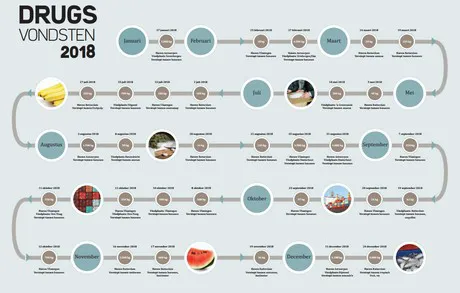The Dutch Public Prosecutor announces that drugs have been intercepted in the Port of Rotterdam nearly every week. In by far the majority of these reports, the cocaine is hidden in a container filled with bananas. In Rotterdam, 18,947 kilos of cocaine were found last year. The authorities in Antwerp found nearly three times as much: 50,000 kilos. It was a new record year since 2012 for both ports.

Click here for enlargement
Hard figures of the interceptions are not public. Once per year, the Public Prosecutor of the Netherlands presents the total figures, but the figures behind the interceptions aren’t published. We made our own inventory of the interceptions in fruit in the past year, based on press reports published after discoveries by the Prosecutor. It’s surprising lthat one report was discussed in the Colombian media, reporting 1,188 kilos of cocaine intercepted in the Netherlands hidden among avocados. The Dutch authorities do not report this finding.
Antwerp, Rotterdam, Vlissingen
A first glance at the figures shows that the largest discoveries of 1,000 kilos or more mostly arrived on the continent via the Port of Antwerp. The mega-findings of 3,500 kilos of cocaine at transport company Van Wanrooy last August fires the imagination. The container used to hide the narcotics was unloaded in Antwerp. The police removed the drugs from the container and followed the lorry to the industrial estate in lmOosterhout.
Smaller batches mostly arrived via the Dutch ports, and these batches amounted to several dozens to hundreds of kilos of cocaine. That changed in the final weeks of the year. In the period around Christmas, nearly 4,000 kilos of drugs were intercepted. The drugs were hidden in the construction of the containers, but were also hidden among fish and tropical fruit. The Public Prosecutor mentions the interceptions in the Port of Rotterdam. Based on the press releases, the role played by the Port of Vlissingen in the smuggling shouldn’t be underestimated either. Our inventory shows that about 3,300 kilos of cocaine were intercepted here over the year.
HARC and Kali against smuggling
In the Netherlands, Customs, FIOD, the Dutch Seaport Police and the Public Prosecutor are part of the HARC team. The Belgian authorities started a similar cooperation for the Port of Antwerp; Customs, police, financial and social services are working together in the Kali team. Both teams work with foreign services as well.
It’s unknown how much of the total flow is intercepted. Experts agree it’s probably just the tip of the iceberg. Smuggling is a threat to trade as well. No trader wants their batch to be abused by the smugglers. The desire to scan all containers with bananas upon arrival is therefore often heard. Besides the fact that Customs’ scanning capacity is insufficient to check all those containers, it would also result in a shift of the flow. It doesn’t matter to the criminals which product is shipped in the container; bananas, pineapple, fruit pulp, they don’t care, as long as it has a constant flow towards Europe. In 2017, the police were already expecting avocados to be used more often as a cover for the smuggling. The reason for this is the growing avocado production in Latin America. Last year, the Public Prosecutor didn’t report contraband among avocados yet, but a batch of 1,000 kilos of cocaine was found in a container of avocados in Spain late 2018.
